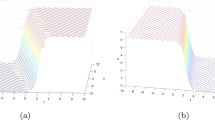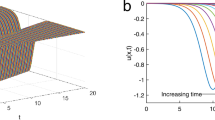Abstract
In the present paper, two integrable and one non-integrable semi-discrete analogues of a generalized sine-Gordon (sG) equation are constructed. The keys of the construction are the Bäcklund transformation of bilinear equations and appropriate definition of the discrete hodograph transformation. We construct N-soliton solutions for the semi-discrete analogues of the generalized sG equation in the determinant form. In the continuous limit, we show that the semi-discrete generalized sG equations converge to the continuous generalized sG equation. Furthermore, we propose four self-adaptive moving mesh methods for the generalized sG equation, two are integrable and two are non-integrable. Integrable and non-integrable self-adaptive moving mesh methods are proposed and used for simulations of regular, irregular and loop soliton while comparing with the Crank-Nicolson (C-N) scheme. The numerical solutions show that the proposed self-adaptive moving methods perform better than the C-N scheme.








Similar content being viewed by others
Availability of supporting data
Data sharing not applicable to this article as no datasets were generated or analyzed during the current study.
References
Fokas, A.S.: On a class of physically important integrable equations. Physica D. 87, 145–150 (1995)
Lenells, L., Fokas, A.S.: On a novel integrable generalization of the sine-Gordon equation. J. Math. Phys. 51, 023519 (2010)
Matsuno, Y.: A direct method for solving the generalized sine-Gordon equation. J. Phys. A: Math. Theor. 43, 105204 (2010)
Matsuno, Y.: A direct method for solving the generalized sine-Gordon equation II. J. Phys. A: Math. Theor. 43, 375201 (2010)
Hirota, R.: Nonlinear partial difference equations. III. Discrete sine-Gordon equation. J. Phys. Soc. Jpn. 43, 2079–2086 (1977)
Orfanidis, S.: Discrete sine-Gordon equations. Phys. Rev. D 15, 3822–3827 (1978)
Feng, B., Maruno, K., Ohta, Y.: Integrable discretizations of the short pulse equation. J. Phys. A Math. Theor. 43, 085203 (2010)
Levi, D., Ragnisco, O. (eds.): SIDE II-Symmetries and Integrability of Difference Equations (CRM Proc and Lecture Notes vol 25). AMS, Montreal (1998)
Grammaticos, B., Kosmann-Schwarzbach, Y., Tamizhmani, T. (eds.): Discrete Integrable Systems (Lecture Notes in Physics vol 644). Springer, Berlin (2004)
Suris, Y.: The Problem of Integrable Discretization: Hamiltonian Approach (Progress in Mathematicsvol vol 219). Basel, Birkháuser (2003)
Bobenko, A., Suris, Y.: Discrete Differential Geometry (Graduate Studies in Mathematics vol 98). AMS, RI (2008)
Yu, G., Xu, Z.: Dynamics of a differential-difference integrable (2 + 1)-dimensional system. Phys. Rev E 91(06), 2015 (2902)
Zhang, Y., Chang, X., Hu, J., Hu, X., Tam, H.: Integrable discretization of soliton equations via bilinear method and Bäcklund transformation. Science China Mathemtatics 58, 279 (2015)
Dimakis, A., Muller-Hoissen, F.: Bidifferential calculus approach to AKNS hierarchies and their solutions. SIGMA 6, 055 (2010)
Matsuno, Y.: A novel multi-component generalization of the short pulse equation and its multisoliton solutions. J. Math. Phys. 52, 123702 (2011)
Feng, B., Maruno, K., Ohta, Y.: Integrable semi-discretization of a multi-component short pulse equation. J. Math Phys. 56, 043502 (2015)
Feng, B., Maruno, K., Ohta, Y.: An integrable semi-discretization of the Camassa-Holm equation and its determinant solution. J. Phys. A Math. Theor. 41, 355205 (2008)
Hirota, R.: The Direct Methods in Soliton Theory. Cambridge University Press, Cambridge (2004)
Feng, B.: An integrable coupled short pulse equation. J. Phys. A: Math. Theor. 45, 085202 (2012)
Feng, B.: (Etc.). Integrable discretizations and self-adaptive moving mesh method for a coupled short pulse equation. J. Phys. A: Math. Theor. 48, 385202 (2015)
Funding
G. Yu’s work is supported by the National Natural Science Foundation of China, Grant Nos.11871336, 12175155, and Shanghai Frontier Research Institute for Modern Analysis, PR China. B. Feng’s work is partially supported the National Science Foundation (NSF), Grant No. DMS-1715991; U.S. Air Force for Scientific Research (AFOSR), Grant No. W911NF2010276.
Author information
Authors and Affiliations
Contributions
B. Feng proposed the original idea and made the review of the manuscript. H. Sheng contributed the numerical simulation. G.Yu conducted the simulation, visualization and wrote the manuscript draft. Both authors read and approved the final manuscript.
Corresponding author
Ethics declarations
Ethics approval and consent to participate
Not applicable
Consent for publication
Not applicable
Human and animal ethics
Not applicable
Competing interests
The authors declare no competing interests.
Additional information
Publisher’s note
Springer Nature remains neutral with regard to jurisdictional claims in published maps and institutional affiliations.
Appendix
Appendix
Here we present the proof of Proposition 3. From the definition of ϕk,uk and equations (3.18)–(3.19), we have
Therefore
which results in
i.e.,
Thus, we complete the proof.
Rights and permissions
Springer Nature or its licensor (e.g. a society or other partner) holds exclusive rights to this article under a publishing agreement with the author(s) or other rightsholder(s); author self-archiving of the accepted manuscript version of this article is solely governed by the terms of such publishing agreement and applicable law.
About this article
Cite this article
Feng, BF., Sheng, HH. & Yu, GF. Integrable semi-discretizations and self-adaptive moving mesh method for a generalized sine-Gordon equation. Numer Algor 94, 351–370 (2023). https://doi.org/10.1007/s11075-023-01504-1
Received:
Accepted:
Published:
Issue Date:
DOI: https://doi.org/10.1007/s11075-023-01504-1
Keywords
- Generalized sG equation
- Integrable discretization
- Discrete hodograph transformation
- Self-adaptive moving mesh method




